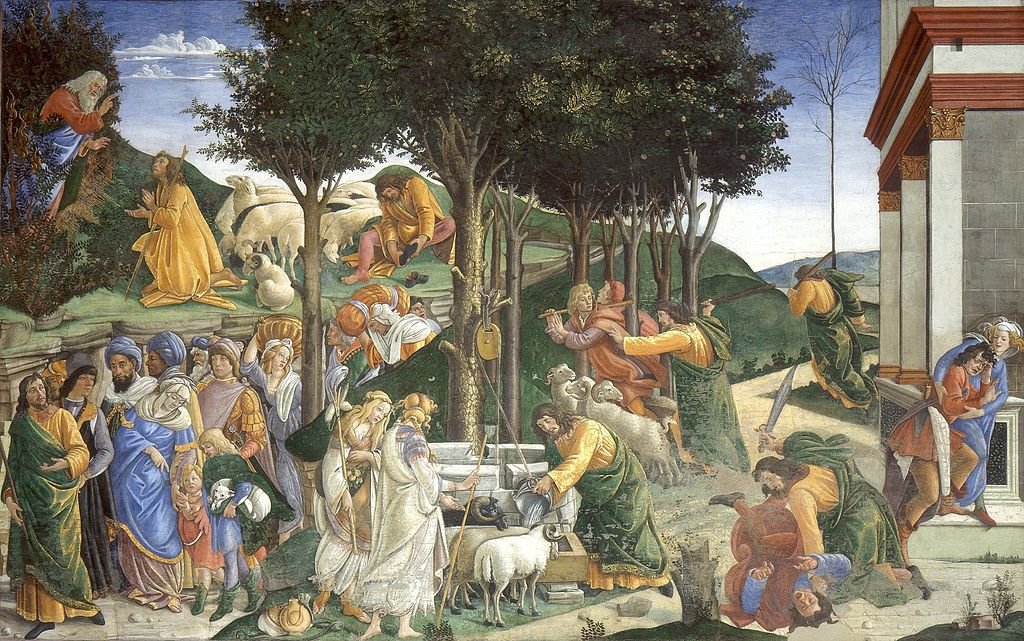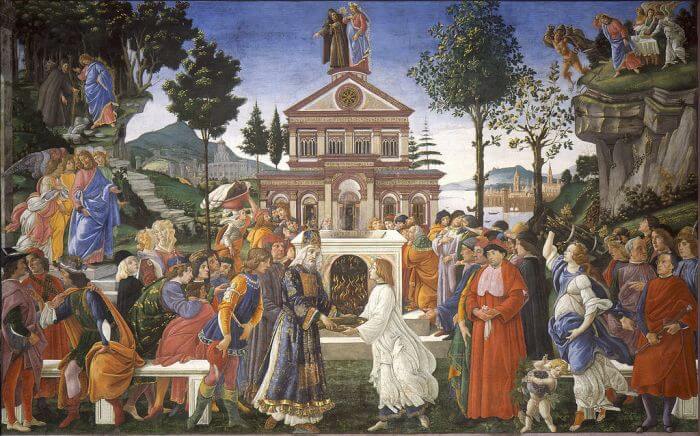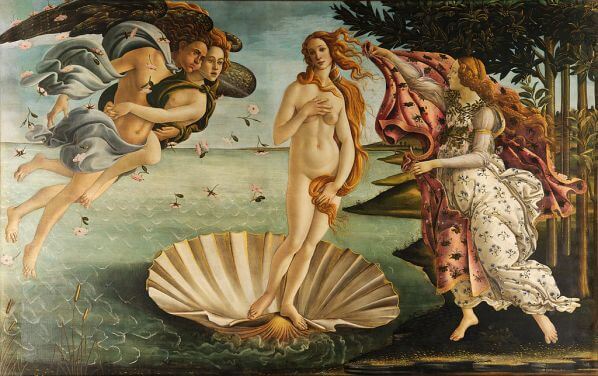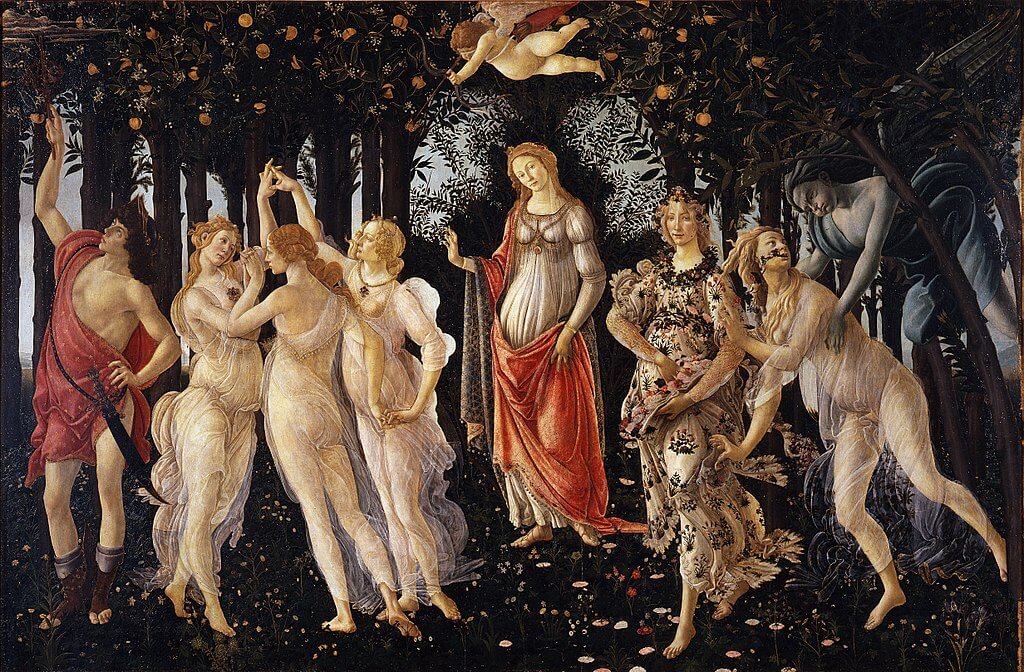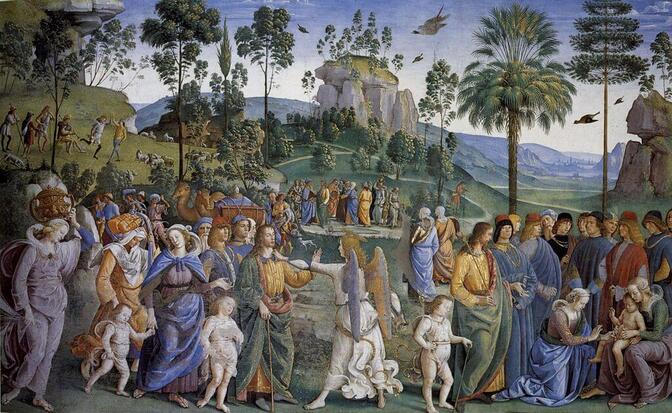|
Where? On the south wall of the Sistine Chapel in the Vatican Museums
When? 1481-1482 Commissioned by? Pope Sixtus IV What do you see? Seven scenes from the early life of Moses. In each scene, Moses is dressed in a yellow dress, and in five of them, he also wears a green cloak on top of it. The scenes illustrate the phases of Moses’ early life and how he became ready to become the leader of the Israelites.
The Biblical story: This fresco is based on the biblical stories as told in the book of Exodus. In Exodus 2:12, Moses kills an Egyptian man who was beating a Hebrew man. In Exodus 2:15, Moses decides to flee to Midian as the Pharaoh planned to kill him for his deed. In Exodus 2:16, Moses chases the men that were preventing the daughters of Reuel (also known as Jethro) to get water for their sheep and he helped them to give water to their sheep. In Exodus 3:5, God asks Moses to take off his sandals. In Exodus 3, Moses sees God in a burning bush, and God speaks to him and tells him that he should lead the Israelites out of Egypt. In Exodus 13:17, Moses leads the Israelites out of Egypt.
Symbolism: This painting contains many symbols, some of which are discussed below. In the scene where Moses flees from Egypt to Midian, you can see a tall tree without any leaves in front of him. This tree signifies the Tree of Knowledge to indicate that Moses will transform himself into a better person when he moves to Midian. In the scene where Moses helps the daughters of Reuel to provide water to their sheep, the woman on the left is Zipporah who Moses will marry later. She has a myrtle leave in her hair which symbolizes the conversion of a non-Jewish person to Christian faith. She also holds a spindle in her right hand (a device to spin wool into a thread), which is a reminder of the Virgin Mary. The water that Moses pours into the trough is a symbol of Baptism and the sheep symbolize the Church. In the scene on the top left, Moses has suddenly a golden rod in his hand which he received from God to lead the Israelites. Who is Botticelli? Alessandro di Mariano di Vanni Filipepi, better known as Sandro Botticelli, was born around 1445 in Florence where he also died in 1510. He spent most of his life in Florence, except between 1481 and 1482 when he painted three frescos in Rome, and an earlier period in which he spent some months in Pisa. He was an apprentice of Fra Filippo Lippi who taught him how to draw, paint, and how to create frescos. He completed various frescos during his life, but several of his Florentine frescos have been lost over time. He is best known for his framed paintings, including The Birth of Venus and La Primavera, which are both in the Uffizi Museum.
Fun fact: In the scene where Moses helps the daughters of Reuel, only two daughters are present, while the Bible mentions that there are seven daughters. The left of the two daughters is Zipporah, who Moses will marry later on. The fresco to the right of this one by Botticelli is made by Perugino and depicts Moses leaving from Midian to Egypt. In the scene on the right of this fresco, Moses is asked to circumcise his son Eliezer, who he got with his wife, Zipporah. So, while the frescos on this wall should be chronologically over time from right to left, occasionally the chronology is incorrect.
Written by Eelco Kappe
References:
0 Comments
Leave a Reply. |
Categories
All
|
- Home
- Blog
-
Museums
- Alte Pinakothek
- Art Institute of Chicago
- Baltimore Museum of Art
- Barber Institute of Fine Arts
- Bargello
- Barnes Foundation
- British Museum
- Church of Sant’Anastasia
- Cleveland Museum of Art
- Courtauld Institute of Art
- Detroit Institute of Arts
- Frans Hals Museum
- Galleria Borghese
- Gallerie dell'Accademia
- Getty Museum
- Guggenheim
- Hermitage Museum
- Kunsthistorisches Museum
- Kunstmuseum Basel
- Legion of Honor Museum
- Louvre
- Mauritshuis
- Metropolitan Museum of Art
- Musee d’Orsay
- Museum of Fine Arts in Boston
- Museum of Modern Art
- National Gallery in London
- National Gallery of Art
- National Museum in Poznań
- Norton Simon Museum
- Ny Carlsberg Glyptotek
- Palace of Versailles
- Palazzo Pitti
- Palazzo Vecchio
- Petit Palais
- Philadelphia Museum of Art
- Prado
- Pushkin Museum
- Ravenna Art Museum
- Rijksmuseum
- San Diego Museum of Art
- Santa Maria delle Grazie
- St. Peter's Basilica
- Städel Museum
- Statens Museum for Kunst
- Tate Britain
- Tate Modern
- Timken Museum of Art
- Uffizi
- Vatican Museums
- Wallace Collection
-
Artists
- Altdorfer
- Anguissola
- Berlin Painter
- Bosch
- Botticelli
- Boucher
- Bronzino
- Bruegel the Elder
- Brunelleschi
- Cabanel
- Caillebotte
- Canova
- Caravaggio
- Carpeaux
- Cezanne
- Cimabue
- David
- Degas
- Delacroix
- De Maria
- Donatello
- El Greco
- Fontana
- Fra Angelico
- Fragonard
- Gauguin
- Gentileschi
- Gericault
- Gonzalez-Torres
- Goya
- Hals
- Hogarth
- Hokusai
- Ingres
- Leonardo da Vinci
- Lippi, Filippo
- Longhi, Barbara
- Lorrain
- Makovsky
- Manet
- Massys
- Matisse
- Merian
- Michelangelo
- Mochi
- Modigliani
- Monet
- Panini
- Parmigianino
- Perugino
- Picasso
- Pisanello
- Raphael
- Rembrandt
- Renoir
- Reynolds
- Rivera
- Rodin
- Rubens
- Scultori
- Seurat
- Steen
- Tintoretto
- Titian
- Toulouse-Lautrec
- Turner
- Uccello
- Van der Weyden
- Van Dyck
- Van Eyck
- Van Gogh
- Van Hemessen
- Vasari
- Velazquez
- Vermeer
- Veronese
- Vigée Le Brun
-
Locations
- Books
- About Us

